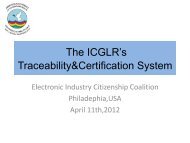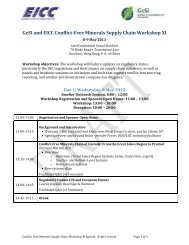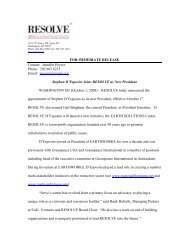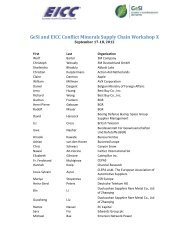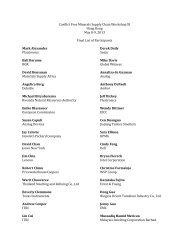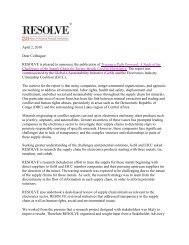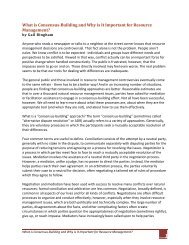Toward SuSTainabiliTy: The roleS and limiTaTionS of ... - Resolve
Toward SuSTainabiliTy: The roleS and limiTaTionS of ... - Resolve
Toward SuSTainabiliTy: The roleS and limiTaTionS of ... - Resolve
Create successful ePaper yourself
Turn your PDF publications into a flip-book with our unique Google optimized e-Paper software.
Chapter 2: Actors – NGOs <strong>and</strong> Civil Society 24requirements were met (Highleyman, Amos, &Cauley, 2004). In another example, a challengeto the MSC’s certification <strong>of</strong> South Georgiantoothfish by the National Environmental Trust(NET), along with Greenpeace, the Sierra Club,<strong>and</strong> other organizations, was upheld (Highleymanet al., 2004) based on its potential to confuseconsumers. NET was conducting a campaign topersuade consumers to “take a pass on Chileansea bass” (the name under which toothfish wasmarketed). Despite the evidence that the smallSouth Georgian fishery was well managed, most<strong>of</strong> the global catch <strong>of</strong> toothfish remained unsustainable<strong>and</strong> illegal.Engaging Consumers <strong>and</strong>Strengthening ConsumerInfluenceCivil society organizations serve to represent <strong>and</strong>give voice to consumers as citizens, stakeholders,<strong>and</strong> owners <strong>of</strong> public goods <strong>and</strong> resources; toeducate <strong>and</strong> mobilize consumers to build dem<strong>and</strong>for certified products (or not—see Box 2.1); <strong>and</strong>to exert indirect influence over companies’ decisionsto use certification.Consumers who buy environmentally friendly orsocially responsible products presumably expecteither private benefits from the products (forexample, health benefits from organic or naturalfoods <strong>and</strong> products) or an altruistic “warm glow”associated with contributing to public well-being(Andreoni, 1990). <strong>The</strong>y may place a high value onthe marginal improvements in social problemsmade through their own actions. As noted in theBusiness section <strong>of</strong> this chapter, many consumersindicate a preference for natural <strong>and</strong> sustainableproducts <strong>and</strong> rely on a broad range <strong>of</strong> civil societyorganizations, including those engaged inst<strong>and</strong>ards <strong>and</strong> certification, to ensure that thesepreferences are met.However, consumers can also express theirpreferences through collective action, not onlyin the public sector (e.g., through dem<strong>and</strong>s forlegislation <strong>and</strong> regulation) but also in the market,shaping both dem<strong>and</strong> <strong>and</strong> supply through tactics(aimed at a company or its br<strong>and</strong>s) such asshaming <strong>and</strong> blaming, mobilizing “good cop/bad cop” pressures, <strong>and</strong> campaigning to enlistfellow consumers in punishing bad performers<strong>and</strong> patronizing good ones. Civil society organizationsare <strong>of</strong>ten at the forefront <strong>of</strong> these campaigns(Lyon, 2010).When Greenpeace in 1994 campaigned againstShell Oil’s plans for disposal <strong>of</strong> the Brent Spar oilstorage platform, it initiated a boycott in Germanythat reduced Shell’s sales <strong>of</strong> gasoline by 20 to30 percent (Diermeier, 1996). Not all boycottsare that successful, but the threat <strong>of</strong> a boycottis a very powerful tool in the h<strong>and</strong>s <strong>of</strong> NGOsseeking to influence corporate behavior. Indeed,Conroy (2007a) argues that the use <strong>of</strong> certificationsystems typically begins with a campaign byan NGO against a particular corporate behavior,<strong>of</strong>ten backed by a boycott threat. After a companyaccedes to the NGO’s dem<strong>and</strong>s, a certificationsystem is created to facilitate monitoring <strong>and</strong>compliance with the company’s commitment.NGOs have also learned that they can raiseconcerns about a company’s br<strong>and</strong> image evenwithout a specific boycott threat—especially companieslike Coca-Cola <strong>and</strong> Nike, for whom br<strong>and</strong>image is a large portion <strong>of</strong> overall shareholdervalue. As discussed in the Business section,companies will <strong>of</strong>ten respond quickly <strong>and</strong> evenproactively to protect the reputations <strong>of</strong> theirbr<strong>and</strong>s in the marketplace.<strong>The</strong> exact processes through which NGO communicationsaffect br<strong>and</strong> image remain poorlyunderstood, but it appears such communicationscan help to drive individual consumer purchasedecisions, collective action by citizens <strong>and</strong> consumers,changes in investment practices byinstitutional investors, <strong>and</strong>/or increased politicalpressure from elected <strong>of</strong>ficials. 11Soon after the MSC was formed, a new NGOcalled SeaWeb began using strategic communications<strong>and</strong> social marketing to raise the pr<strong>of</strong>ile <strong>of</strong>ocean conservation issues. It conducted marketresearch to determine what messages resonated<strong>and</strong> began educating consumers about the11 See Lyon <strong>and</strong> Shimshack (forthcoming) for an attempt toidentify the channels through which Newsweek’s GreenCompany Ratings affected shareholder value.<strong>Toward</strong> Sustainability: <strong>The</strong> Roles <strong>and</strong> Limitations <strong>of</strong> Certification



